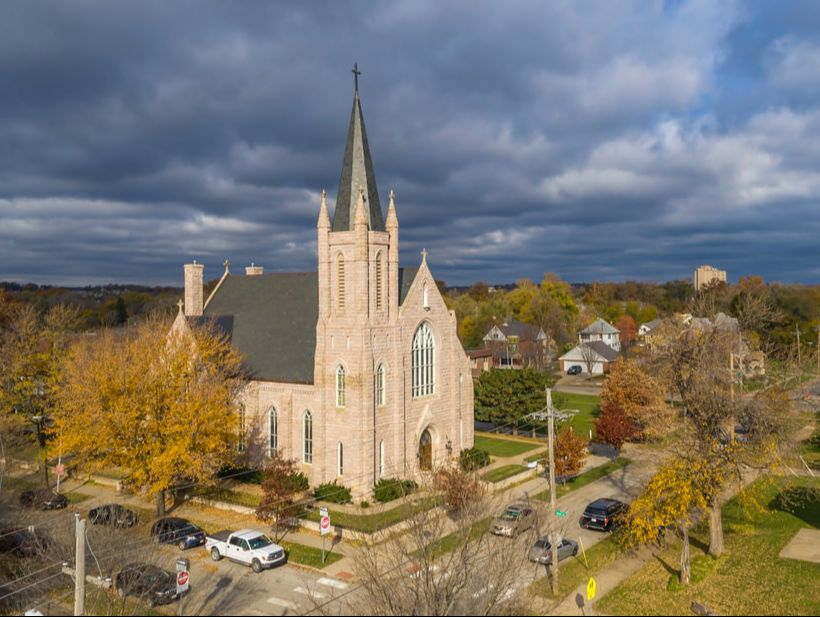Nebraska church lives its mission through solar
- IRA,
- Stories

The pews of Sacred Heart Church in Omaha, Nebraska, fill up with parishioners from across the metro area. “Sacred Heart is what I like to refer to as a destination parish,” said Fr. Dave Korth, who leads the North Omaha congregation. He says members are drawn to the church’s embrace of creation care, social justice, and community service. To support its mission, the church installed solar panels in 2023 and again in 2024.
Fr. Dave first explored solar in 2019 but encountered roadblocks that made the project financially challenging. The primary federal incentive for renewable energy projects has historically been tax credits. Because nonprofits like churches don’t pay taxes, Sacred Heart was unable to benefit from federal programs that help make solar more affordable, so the project was tabled.
Despite the setback, the hope of going solar remained, and a few years later, Sacred Heart decided to fundraise within the congregation for a system on their parish office. Though smaller than originally planned, it would help offset electricity costs with clean energy. By the time the planned 40-kilowatt solar array was ready to be installed, though, the landscape of incentives available to nonprofits had changed.

In 2022, the federal government passed legislation creating a pathway for tax-exempt entities like Sacred Heart to receive a cash payment in place of a tax credit. This program, called Direct Pay, matches the 30% deduction available to homeowners and businesses. Through the new law, the church can also secure an additional 10% savings on the $40,000 system through the Clean Electricity Low-Income Communities Bonus Credit Program. The advent of Direct Pay means Sacred Heart can recoup $16,000 on this solar investment. It also opened the door to pursue a larger project.
Fr. Dave is president of the CUES School System. CUES consists of three Omaha elementary schools serving a majority of low-income students and families. One of those schools sits adjacent to the church and has a roof tailor-made for solar.
In 2024, enabled by Direct Pay, the school installed a 70-kilowatt solar array projected to offset 30% of its energy demand. The array was comprised of new panels as well as used ones donated by Creighton University to help lower costs.
To make the cash flow work, Sacred Heart Church loaned the school $124,000 — 40% of the total project cost — which would be repaid using Direct Pay funds. While their applications have been accepted, they have yet to receive the money for either project, leaving them in a state of uncertainty as the program is currently in jeopardy.
Despite bipartisan support, solar opponents in Congress are looking to eliminate pro-solar investments like clean energy tax credits and Direct Pay. Doing so would mean a huge financial blow to the church. “If that goes away, we’re going to have to somehow figure out refinancing, and that’s going to be a problem,” said Fr. Dave. “If we don’t get that 40% coming back in the Direct Pay that has to come from somewhere else … we don’t have a plan for that.”
The money Sacred Heart saves on operating costs by going solar can be reinvested into serving its community — through Sacred Heart School and its efforts to support underserved kids, as well programs like Heart Ministry Center, which provides food, health care, job placement, and laundromat services to vulnerable members of the Omaha community. Missing out on a total of $140,000 in Direct Pay savings will create budget strain that impedes resources from flowing out to the community. It would also hinder plans to install solar on the other CUES schools.
“[Direct Pay] is extremely important for this project, but I think for any nonprofits looking at trying to utilize renewable [energy] sources going forward, it’s imperative to make them attractive,” said Fr. Dave. By going solar, nonprofits like Sacred Heart not only save money but also strengthen their ability to fulfill their missions. The opportunity for upfront savings through Direct Pay means more organizations and faith communities can now access these benefits.
“If we can do this in one of the most financially depressed areas of our city, surely other people can figure out how to do it,” reflected Fr. Dave. Direct Pay was essential in helping Sacred Heart achieve its solar goals. For other nonprofits looking to benefit from distributed renewable energy, preserving the program will be critical.
Act Now: Urge Congress to protect solar energy tax credits for all Americans
Solar energy is garnering support from both sides of the aisle. You can help keep up the momentum by making it loud and clear to your Senators and Representatives that Americans support federal solar investments.
Some members in Congress want to repeal successful policies that have made going solar more affordable for American families and businesses. Please use the form on this page to tell your federal representatives that you support smart investments, like the 30% solar tax credit.
Personalize your message!
If you have solar, explain how it is lowering and controlling your household’s energy costs. If you don’t yet have solar, tell them how these investments will make solar accessible for people like you.
Get the latest on solar straight to your inbox.
Fight for your solar rights.
Everyone has the right to go solar. Spread the sunshine nationwide and in your local community by taking action, joining events, and more.